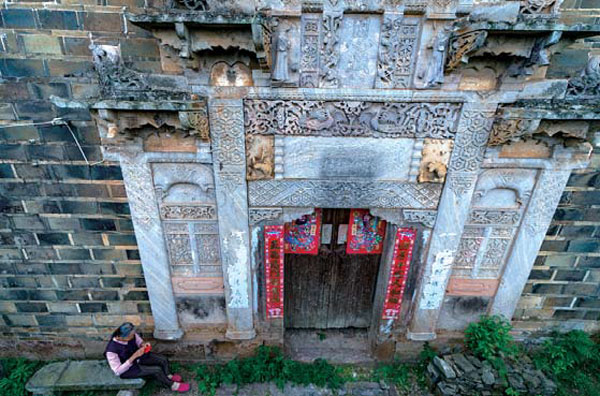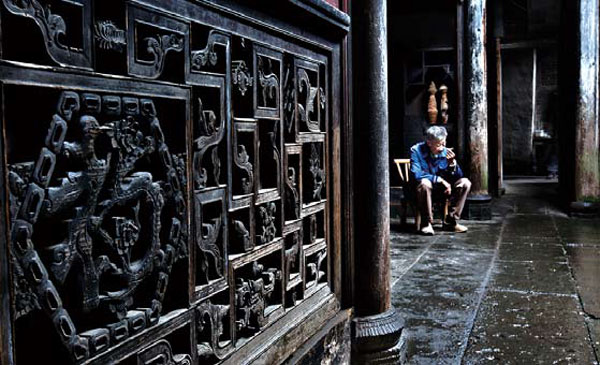Saving a home for history
Updated: 2016-04-29 08:27
By Deng Zhangyu(China Daily Europe)
|
|||||||||
|
|
With the country's modernization, ancient villages are disappearing at a fast pace as old houses are replaced by new buildings. But a county in East China is seeking to reverse the trend
When twilight falls, Hu Qinghua's routine starts. After he finishes work in his rice fields he visits a family in Youdian village. He speaks to them about the history of their house and narrates stories about their common ancestors. His hope is to persuade them to repair their house, built hundreds of years ago.
Hu, 63, can trace his ancestry back more than 20 generations in an ancient village in East China's Jiangxi province. All the buildings of Hu's village in Jinxi county date back to the Ming Dynasty (1368-1644).
However, most of the houses are empty. And some are even on the verge of collapse.
"Young people move to cities, leaving their parents behind in the village. It's almost empty now," says Hu.
Hu's village is one of more than 100 ancient villages in Jinxi. All these villages have traditional houses, some built also in styles of the Qing Dynasty (1644-1911). There are about 11,000 houses built during one of the two dynasties in the county, according to the local government.
"It's like a huge museum of ancient architecture. It's rare to see ancient houses that are mostly in their original forms in such large numbers in China," says Guo Daiheng, an expert on Chinese traditional architecture. With China's modernization, ancient villages are disappearing at a fast pace as residents replace old houses with modern buildings. An average of 100 villages are vanishing each day in China, scholar Feng Jicai remarked during last year in Beijing.
But not all old houses are demolished. Some are transformed into tourist attractions, and the local residents are replaced by businesspeople.
Guo says houses in Jinxi have retained their old forms because locals have great respect for their ancestors.
"People don't demolish old houses. They may leave for the cities or build new houses near their village," says Guo, whose team has been in the area for two months now with the sole aim of studying the houses and protecting them.
She has helped with a conference called Digital Heritage Around China to raise awareness and money for the preservation of ancient villages.
In Youdian village, there are 72 traditional stone buildings with walls that are several meters high. The village's most famous ancestor was Hu Guifang, a senior official in the Ming Dynasty, who was in charge of construction, transportation and agriculture. He returned to the village after he retired.

The village mainly houses descendants of the official. They have lived in the buildings built by their ancestors for generations.
Other villages in Jinxi share many similarities with Youdian. They have ancestral temples, schools and houses with similar layouts that include ponds, and long and narrow stone alleys. Well-known ancestors of today's villagers were influential scholars, writers, poets and powerful officials in Imperial China.
All these villages have been influenced by Confucianism and Taoism, says Guo. That's why they are built in harmony with the surrounding rivers and mountains.
Now, all these villages face a common problem - people are leaving and the houses are decaying.
Meanwhile, Hu Qinghua's daily visits and persuasion have continued for more than a year.
For the few residents of the village, they recognize that their houses must be preserved as a kind of cultural heritage after the local government offered them money to help with repairs.
"I told them (the villagers) that if they don't repair their houses, it's a kind of disrespect to their ancestors," says Hu. Most villagers take his words seriously, but they can't afford the cost of repairs.
To repair an ancient house takes a lot of money. Just to stabilize it and fix its wooden windows can cost about 30,000 yuan ($4,600; 4,100 euros). But the average annual income of villagers who work in the rice fields is about 10,000 yuan, says Hu.
Huang Qinhua, a local official in Jinxi, says: "A resident often pays 2,000 to 6,000 yuan for the repairs, and the government covers the rest."
Huang says the local government also wants to bring in private funds to protect the ancient villages.
For instance, Guo's team and the organizer of Digital Heritage Around China have promised to help fix decaying houses. But Guo says repairing the houses is relatively easy compared with convincing young villagers to return home from the cities.
These villages that rely mainly on agriculture can't provide adequate job opportunities like big cities do. However, Guo says she sees hope when she meets young people making plans for their hometowns.
A young man who Guo met this year told her that he realized the value of the houses in his village when he saw how ancient properties are protected in other countries.
So he has decided to return home and to start work on repairing his own house.
"In China, the link between people and their villages is very powerful, so there's hope that the next generation will respond," she says.
dengzhangyu@chinadaily.com.cn
|
|
|
|
Today's Top News
Running the world
Getting back to basics
Alibaba denies reported takeover of AC Milan
China stresses Putin's expected visit
Russia launches rocket from Vostochny Cosmodrome
Record number of Chinese exhibitors at Spanish expo
Beijing least affordable city in the world to rent
US accused of 'hyping up' military flights
Hot Topics
Lunar probe , China growth forecasts, Emission rules get tougher, China seen through 'colored lens', International board,
Editor's Picks

|

|

|

|

|

|










